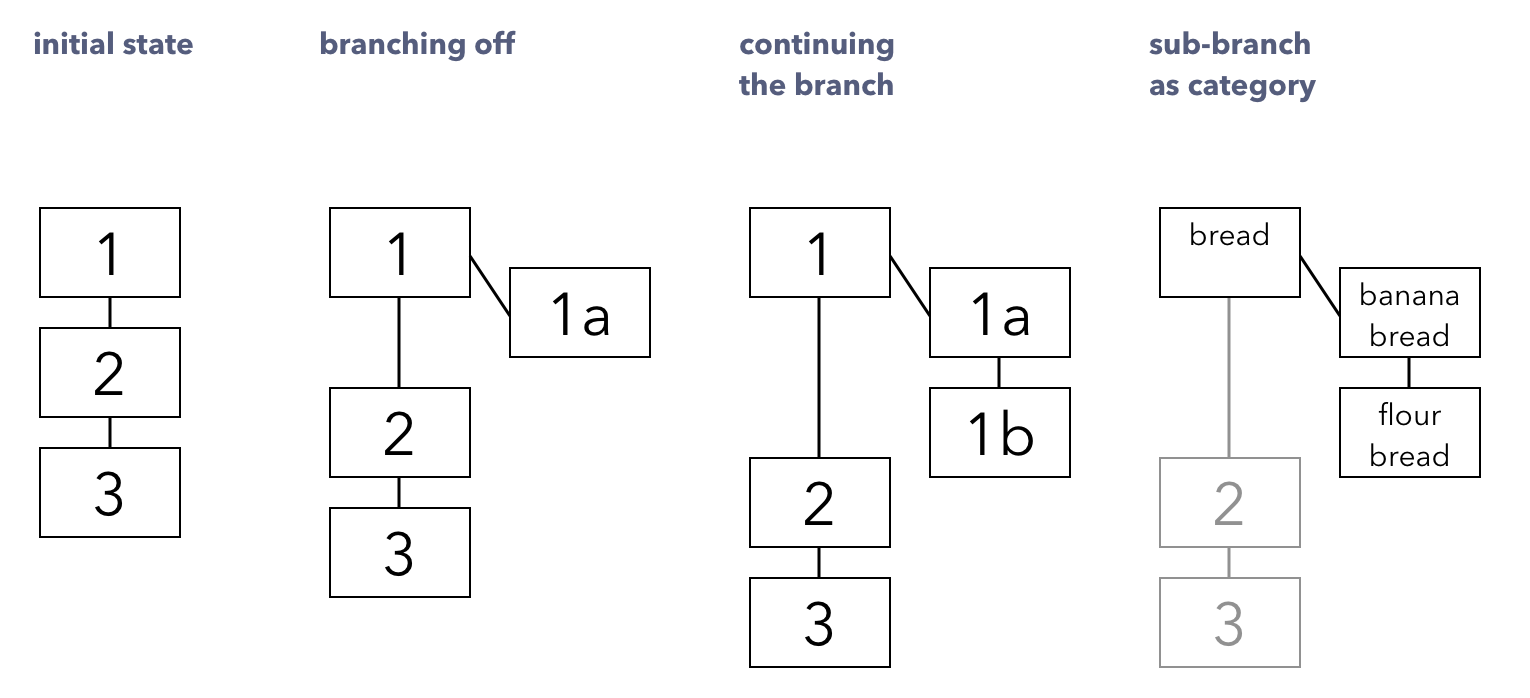No, Luhmann Was Not About Folgezettel
I follow a principle that Ido Portal put nicely into words:
Principles are higher than techniques. Principles produce techniques in an instant.
—Ido Portal
During my journey of developing the Zettelkasten Method, I recall two phases:
- I collected features. These are the techniques you can use to develop a complex system of concepts, statements, arguments and models that make something we call a Zettelkasten, a second brain, which is more than just a second memory.
- I got rid of most of the features after I realized that they are redundant or a just plain harmful when they slowed me down.
I find these two phases in most of the processes I develop. This is because I am (1) an information binge eater and (2) hate clutter.
One piece of clutter was the concept of Folgezettel.
Update 2020-04-15: The topic re-emerged after a couple of years. There is quite some discussions in the forum. For example: Here, here and here. See this new post from 2020 for an expansion on that topic.
What is a Folgezettel?
A Folgezettel is a child to his parent note. Simple as that.
In the past, we’ve translated this German word as “sequence of notes”, which is how Luhmann came up with the concept.
Daniel Lüdecke on Luhmanns Zettelkasten
Recently, I read on Daniel Lüdecke’s Blog his latest article about Luhmann’s Zettelkasten (German). For you fellows who don’t speak German, here’s a short summary of Daniel’s point of view:

- What most people think Luhmanns Zettelkasten is about: It is the linking through tags and cross-references.
- What it is actually about: It is mainly about the concept of Folgezettel. This means that you develop an idea in a linear way and branch off if the next thought doesn’t fit into the previous string of ideas.
I disagree on multiple levels with Daniel. With links alone you can do what Luhmann had to achieve with the Folgezettel technique. So let’s dive into the arguments:
Luhmann was not about Folgezettel

Luhmann, the godfather of the Zettelkasten Method himself, wrote that it is not important where you store a Zettel as long as you can reference it from every other point to the Zettelkasten.1
The possibility to create a direct reference, for example as a link, reduces the importance of the Zettel coming next in the sequence. The technique Folgezettel creates value from the position of a Zettel in the archive. But the technique of creating a link reduces the value of the position of a Zettel.
Looks like a paradox, doesn’t it?
But Luhmann gave us a technique to handle these. He called it “unfolding a paradox”.2 You take a step back and make another distinction.
Daniel Lüdecke wrote that Luhmann relied heavily on the technique of Folgezettel and I think that he is right. But it doesn’t follow from Luhmann’s principles but rather came as a consequence of him having to deal with a physical Zettelkasten. It is accidental, not foundational for his success.
If Luhmann would have used the other reference technique of creating links exclusively, he would have lost plenty of time literally flipping trough his paper-based Zettelkasten.
So it seems that although Folgezettel were indeed a very important factor for Luhmanns success, this is mostly due to the physical nature of his archive.
Let’s take a step back to re-evaluate the question: What is a Folgezettel?
A Folgezettel is a specific and intended connection between Zettels, realized through their position in the archive. You put a Zettel in a specific place and end up with a Folgezettel, which is nothing more than a connection between the preceding note and this new Zettel as a Folgezettel.
This connection can intend several things:
- continue a thought
- add an idea to a thought
- exclude a thought from the existing line of thoughts (Folgezettel could mark a blind end. That means it says what conclusion not to make.
Let’s summarize what we have so far. A Folgezettel
- has a special value for a physical Zettelkasten
- is an intended connection
- can have different intentions
Is there any good reason for a Folgezettel so far? I say no. We don’t have a physical Zettelkasten and we can connect notes with links. The intent of a Folgezettel is not always clear, so we can even improve the situation by creating annotated links.
Multiple storage with tags
Nowadays, you can look at some of Luhmann’s original Zettel notes. Luckily, his register is available online, too. You can clearly see that Luhmann had to deal with the shortcomings of his method of Folgezettel.

“Anpassungsfähigkeit”, as you see there, was not only to be found in one place. You could find it in 21/3a7 and 54/14z/1.
Luhmann himself wrote: It is not important where you store a Zettel as long as you can reference it from every other point to the Zettelkasten!1
His register is truly just a map for his Zettelkasten to find a useful entrance. After entrying he’d get lost in it and go from connection to connection, sometimes via Folgezettel, sometimes via cross-references or links.
Should you copy a method just because Luhmann used it? I certainly don’t. Luhmann dealt with the flaws of a physical Zettelkasten and developed techniques to actualize a principle. As a user of a digital solution, we have other, even better, choices.
Folgezettel as categories
Didn’t we exclude categories because of their rigidity? To me, the graphs in Daniel’s post look quite similar to using a system of categories, only with the added possibility to link between Zettels.
Folgezettel create some kind of category. Similar principles are applied: You have one and only one connection to the level above.
I am not entirely against categories. In fact, I find them quite useful. I use tags extensively because of that. Tags include the functionality of categories but not the other way around. I have a good chunk of Zettel written on the idea of metabolic flexibility. All the Zettel I have written on that topic have this tag. This way I end up with something that works exactly like a metabolic flexibility category, only without the limitations of a hierarchical system of strict categories.
If I was Luhmann, I’d be happy to have all my Zettels about metabolic flexibility in one physical place. But luckily, I am not Luhmann, suffering from the perils of paper. I just hammer a few characters into the search box – and there are all my relevant Zettel notes. I have the same functionality with less clutter.
Applying the principle of principles and techniques
Folgezettel are a technique to realize a principle. How you realize a principle, that is which technique you use, does not make any difference from a bird’s eye perspective. Of course they appear to be different down on the ground. Like a punch is different from a choke while both follow the principles of combat.
To have a Luhmann-esque Zettelkasten, you don’t have to follow his techniques. Just follow the principles he used and you’ll be fine. In fact, you’ll be better off because you don’t clutter your life through imitating other people’s scenarios.
Our solution
We have one and only one technique of direct and intended connection: We have links. We just insert a “§” with the ID of the Zettel we want to link to and there you have the link.
- If I want to see all the children of a particular note (read: Folgezettel) I just search for its ID with a “§”-prefix.
- If I want a Zettel to be an addition or a continuation of a Zettel I link to it and mark it as a continuation.
That’s it. Not additional features needed. No additional technique, either. It’s simply the application of the principle of connectivity.
Last thoughts
This post is not about bashing Daniel but to use his ideas to advance in a discussion. Don’t get me wrong.
I highly appreciate what Daniel Lüdeckes has done for me with his app. I learned a lot using this app, although I don’t think it is the best choice to realize Luhmann’s principles. Yet it is the best application adapting his techniques I know so far.
On the other side, I stick to principles and not to techniques. I always try to apply the principles of the Zettelkasten Method with the least number of techniques possible. That seems to be an elegant solution.
My knowledge work has improved a lot since I have found the Zettelkasten Method and did improve a lot further since I turned minimalist and used a plain text approach. During the time Christian and I heavily discussed our Zettelkästen, we came to a simple solution: Less is more, most of the time. When it’s not, there is a simpler solution you don’t know yet hidden somewhere.
Update Nov. 2015: There’s a follow-up by Zkn³ developer Daniel Luedecke.